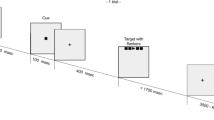Abstract
Real-world speech perception relies on both auditory and visual information that fall within the tolerated range of temporal coherence. Subjects were presented with audiovisual recordings of speech that were offset by either 30 or 300 ms, leading to perceptually coherent or incoherent audiovisual speech, respectively. We provide electroencephalographic evidence of a phase-synchronous gamma-oscillatory network that is transiently activated by the perception of audiovisual speech asynchrony, showing both topological and time–course correspondence to networks reported in previous neuroimaging research. This finding addresses a major theoretical hurdle regarding the mechanism by which distributed networks serving a common function achieve transient functional integration. Moreover, this evidence illustrates an important dissociation between phase-synchronization and stimulus coherence, highlighting the functional nature of network-based synchronization.




Similar content being viewed by others
References
Bushara KO, Grafman J, Hallet M (2001) Neural correlates of auditory-visual stimulus onset asynchrony. J Neurosci 21(1):300–304
Callan DE, Callan AM, Kroos C, Vatikiotis-Bateson E (2001) Multimodal contribution to speech perception revealed by independent component analysis: a single-sweep EEG case study. Cog Brain Res 10:349–353
Calvert GA, Campbell R, Brammer MJ (2000) Evidence from functional magnetic resonance imaging of crossmodal binding in human heteromodal cortex. Curr Biol 10:649–657
Calvert GA (2001) Crossmodal processing in the human brain: insights from functional neuroimaging studies. Cer Cortex 11:1110–1123
Canolty RT, Edwards E, Dalal SS, Soltani M, Nagarajan SS, Kirsh HE, Berger MS, Barbaro NM, Knight RT (2006) High gamma power is phase-locked to theta oscillations in the human neocortex. Science 313:1626–1628
Delorme A, Makeig S (2004) EEGLAB: an open source toolbox for analysis of single-trial EEG dynamics. J Neurosci Methods 134:9–21
Dixon NF, Spitz L (1980) The detection of auditory visual desynchrony. Perception 9:719–721
Doesburg SM, Kitajo K, Ward LM (2005) Increased gamma-band synchrony precedes switching of conscious perceptual objects in binocular rivalry. Neuroreport 2:229–239
Eggermont JJ (2000) Sound-induced synchronization of neural activity between and within three cortical areas. J Neurophysiol 83:2708–2722
Engel AK, Singer W (2001) Temporal binging and the neural correlates of sensory awareness. Trends Cogn Sci 5:16–25
Fingelkurts AA, Fingelkurts AA, Krause CM, Möttönen R, Sams M (2003) Cortical operational synchrony during audio–visual speech integration. Brain Lang 85:297–312
Ford JM, Gray M, Faustman WO, Heinks, Mathalon DH (2005) Reduced gamma-band coherence to distorted feedback during speech when what you say is not what you hear. Int J Psychophysiol 57:143–150
Freeman WJ (2004) Origin, structure, and role of background EEG activity. Part 1. Analytic amplitude. Clin Neurophysiol 115:2077–2088
Fries P (2005) A mechanism for cognitive dynamics: neuronal communication through neuronal coherence. Trends Cogn Sci 9:474–479
Grossberg S (1995) The attentive brain. Am Sci 83:483–449
Jones JA, Callan DE (2003) Brain activity during audiovisual speech perception: an fMRI study of the McGurk effect. Neuroreport 14(8):1129–1133
Kaiser J, Hertrich I, Ackermann H, Lutzenberger W (2006) Gamma-band activity over early sensory areas predicts detection of changes in audiovisual speech stimuli. Neuroimage 15:646–653
Kaiser J, Hertrich I, Ackermann H, Mathiak K, Lutzenberger W (2005) Hearing lips: gamma-band activity during audiovisual speech perception. Cer Cortex 15:646–653
Kanayama N, Sato A, Ohira H (2007) Crossmodal effect with rubber hand illusion and gamma-band activity. Psychophysiol 44: 392–402
King AJ (2005) Multisensory integration: strategies for synchronization. Curr Biol 15(9):R339–R341
Lachaux JP, Rodriguez E, Martinerie J, Varela FJ (1999) Measuring phase synchrony in brain signals. Hum Brain Mapp 8(4):94–208
Lewkowicz DJ (1996) Perception of auditory–visual temporal synchrony in human infants. J Exp Psychol: Hum Percept Perform 22(5):1194–1106
McGurk H, MacDonald J (1975) Hearing lips and seeing voices. Nature 264:746–748
Miller LM, D’Esposito M (2005) Perceptual fusion and stimulus coincidence in the cross-modal integration of speech. J Neurosci 25(25):5884–5893
Perrin F, Bertrand O, Pernier J (1987) Scalp current density mapping: value and estimation from potential data. IEEE Trans Biomed Eng BME 34:283–288
Pikovski A, Rosenblum M, Kurths J (2001) Synchronization: a universal concept in nonlinear sciences. Cambridge University Press, Cambridge 432 p
Rodriguez E, George N, Lachaux JP, Martinirie J, Renault B, Varela FJ (1999) Perception’s shadow: long-distance synchronization of human brain activity. Nature 397:430–433
Schroeder E, Foxe J (2005) Multisensory contributions to low-level “unisensory” processing. Curr Opin Neurobiol 6(4):285–296
Senkowski D, Talsma D, Grigutsch M, Herrmann CS, Woldorff M (2007) Good times for multisensory integration: effects of the precision of temporal synchrony as revealed by gamma-band oscialltions. Neuropsychologia 45(3):561–571
Senkowski D, Talsma D, Herrmann CS, Woldorff M (2005) Multisensory processing and oscillatory gamma responses: effects of spatial selective attention. Exp Brain Res 166:411–426
Shadlen MN, Movshon JA (1999) Synchrony unbound: a critical evaluation of the temporal binding hypothesis. Neuron 24:67–77
Tallon-Baudry C, Bertrand O (1999) Oscillatory gamma activity in human and its role in object representation. Trends Cogn Sci 3(4):151–162
Varela F, Lachaux JP, Rodriguez E, Martinerie J (2001) The brainweb: phase synchronization and large-scale integration. Nat Rev Neurosci 2(4):229–239
von Stein A, Sarnthein J (2000) Different frequencies for different scales of cortical integration: from local gamma to long range alpha/theta. Int J Psychophysiol 38(3):301–313
Ward LM (2003) Synchronous neural oscillations and cognitive processes. Trends Cogn Sci 17:553–559
Wright TM, Pelphrey KA, Allison T, McKeown MJ, McCarthy G (2003) Polysensory interaction along temporal regions evoked by audiovisual speech. Cer Cortex 13:1034–1043
Yuval-Greenberg S, Deouell LY (2007) What you see is not (always) what you hear: induced gamma band responses reflect cross-modal interactions in familiar object recognition. J Neurosci 27(5):1090–1096
Author information
Authors and Affiliations
Corresponding author
Electronic supplementary material
Below is the link to the electronic supplementary material.
Rights and permissions
About this article
Cite this article
Doesburg, S.M., Emberson, L.L., Rahi, A. et al. Asynchrony from synchrony: long-range gamma-band neural synchrony accompanies perception of audiovisual speech asynchrony. Exp Brain Res 185, 11–20 (2008). https://doi.org/10.1007/s00221-007-1127-5
Received:
Accepted:
Published:
Issue Date:
DOI: https://doi.org/10.1007/s00221-007-1127-5




